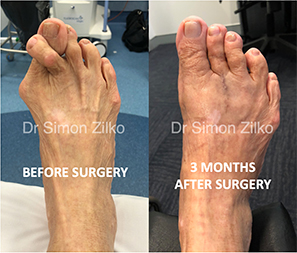Big Toe (1st MTPJ) Fusion

Procedure
Patients are admitted to hospital on the day of surgery, and the procedure is done under a general anaesthetic with an ankle anaesthetic block. The ankle block is the application of local anaesthetic around the ankle, which usually provides pain relief for up to 12 hours after the surgery.
An incision is made over the side of the big toe. Once the joint is entered, any remaining cartilage is cleared away. Special tools are used to prepare the joint surfaces for a perfect fit.
Once prepared, the two bones are positioned together (with any deformity like a bunion corrected), and a plate and screws are used to compress and secure the joint. Once the hardware has been inserted and checked with x-rays, the joint capsule and skin are then closed with stitches.
Recovery & Rehabilitation
Patients are allowed to walk full weightbearing in a stiff-soled surgical shoe from the day of surgery. In general, crutches may be needed for the first 5-10 days after surgery for comfort and balance, but it is fine to discard the crutches earlier if able.
The local anaesthetic block usually makes the foot pain-free for 6-12 hours. Strong pain killers are usually only needed for the first 3-7 days, after which paracetamol is generally all that’s required.
After discharge, the dressings and bandages must all stay intact and dry until review 2 weeks after surgery. During this time, it is particularly important to elevate the foot for most of the day, with “toes above the nose”! Strict elevation helps swelling come down faster, which means less pain and less chance of wound healing issues.
At 2 weeks after surgery, the wound is checked and any sutures are removed (most of the time these will be under the skin).
After 3-4 weeks, patients can transition to wearing a supportive sneaker/sports shoe with a carbon foot plate. At 8 weeks post-op, x-rays are done to check on bone healing, and a final check x-ray is done at 6 months to ensure the fusion has been successful.
The joint generally takes 10 to 12 weeks to fuse in healthy patients. Most activities can be recommenced from 12 weeks post-op, and by 6 months most patients have returned to their normal activities without pain or discomfort. Every patient’s recovery is individual, of course, and depends on many factors.
Return to Work & Activities
Driving: For left foot surgery, patients can drive an automatic car as soon as they’re walking well and off all strong painkillers (usually from 1 week). For right foot surgery or those with a manual car, patients can drive once they’re in a normal shoe, have minimal pain and can safely operate the brake/clutch (usually 3-6 weeks post-surgery).
Work: Office and desk-job workers can go back to work after 2-3 weeks, but those doing manual jobs on their feet often need a full 6-8 weeks off.
Exercise: Most patients can use an exercise bike or elliptical trainer after 4 weeks, and can swim after 6 weeks. Impact exercises such as running or jumping are usually possible after 3-4 months.
Big toe fusion surgery is covered by both Medicare and private health funds only when performed by an orthopaedic surgeon (medical doctor).
Please note that podiatrists performing surgery are not medical doctors; have not undergone medical school and teaching hospital surgical training for 13-15 years like orthopaedic surgeons; are unable to prescribe all antibiotics, painkillers, anti-emetics and other medications that may be required after surgery; and are not covered at all by Medicare for surgery.
You will need the Adobe Reader to view and print these documents. ![]()
